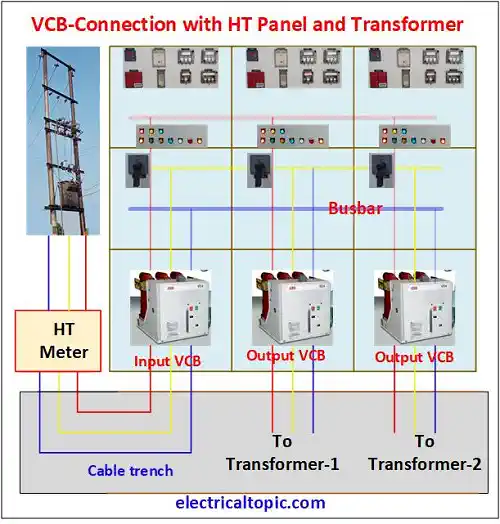Vacuum circuit breaker (VCB)
Working principle, Circuit diagram and Parts.
1- Vacuum circuit Breaker (VCB):

This breaker is used for high voltage in the high tension (HT) panel. It works as a switching device manually
or auto.
It is also used to control and protect of electrical system from overload and short circuit. Where the vacuum
is used
for arc removing medium that breaker is called a vacuum circuit breaker.
It works as air removing from contact-making and breaker chamber. Both fixed and moving contract is closed in
a vacuum
chamber. The arc is extinguished with a high vacuum in the chamber. The range of voltage is 11 KV to 33 KV.
2- Connection Diagram of VCB:

3- Working principle of VCB:
When VCB is operated with fixed or moving contact are connected then during this activity a large arch is quenching with the help of vacuum medium.
Medium of Vacuum is crearted in vacuum chamber. Vacuum means oxygen is not availabel so without oxygen fire can not be activated.
During fault condition VCB is received a trip signal from protection relay then shunt coil is activated and VCB will be tripped.
It is operated as mannual and auto mode or through protection relay during fault condition.
4- Parts of VCB:
An air circuit breaker is an electrical, mechanical, and electronic device. It is a group of different types of parts operating parts, protection parts, and moving mechanisms. The parts details are given below mentioned points.
1- Operating mechanism:
The operating mechanism is the important part of ACB which is used for the operation of on or off. This is operated as manually or electrically. In this on and off push button is installed for manually operating and closing coil and shunt coil is used electrically.
2- Protection release:
Microprocessors-based releases are used for ACB protection. It is used for overload, short circuit, and earth
fault.it
is set as per time set.
The release is an electrical device that is used for mechanical output in pre-defined set points.
different
types of
release are used such as shunt release for tripping, Under-voltage release for voltage monitoring, closing
release for
breaker on condition, spring charging motor for mechanism spring of circuit breaker.
3- Cradle.
Cradle is used for rack in or rack out of ACB. Draw out ACB is installed on the cradle for moving the breaker in and out.
4- Interlocking.:
Interlocking is used for protection in ACB. It is electrically and mechanically types. in electrically the closing coil is interlocked and the operating mechanism is locked manually.
5- Terminal.
Terminals are used for power connecting and disconnecting of the circuit breaker.it is used vertically, horizontally, and rear type.
6- Arch shoot.
The arch shoot is a chamber for quenching the arch during making and breaking contact in the breaker. It is made with many strips in a box so that the arc can be distributed.